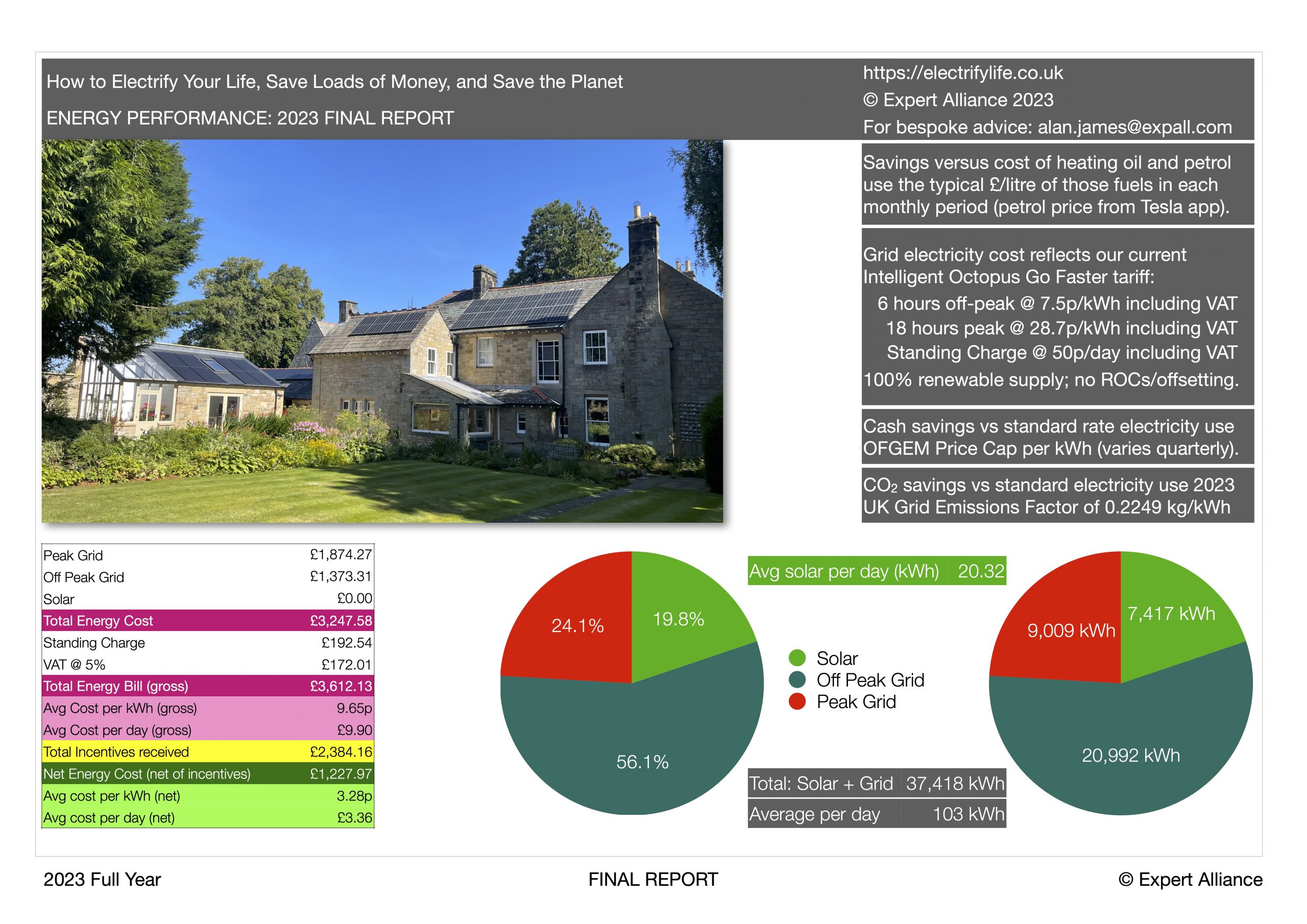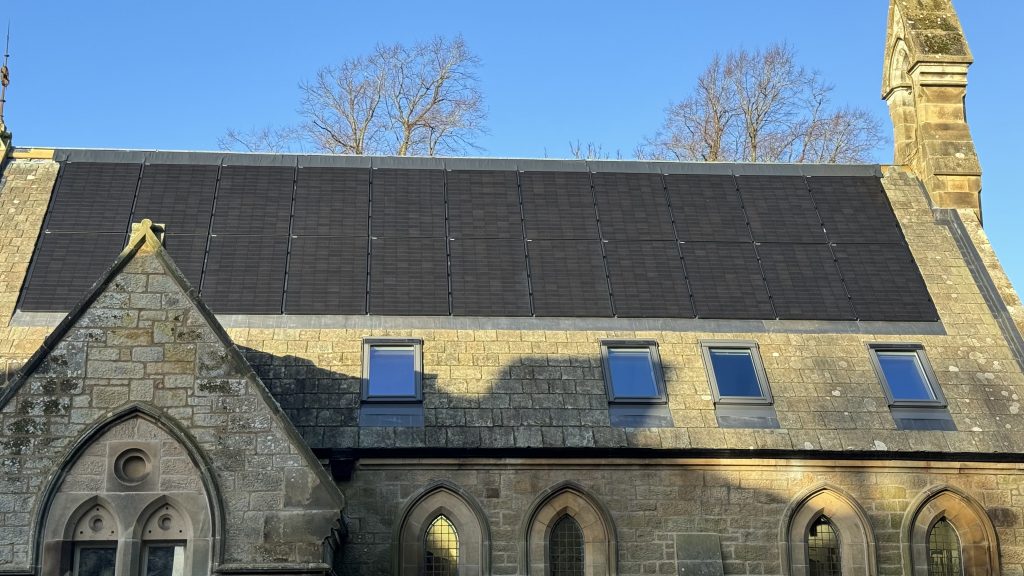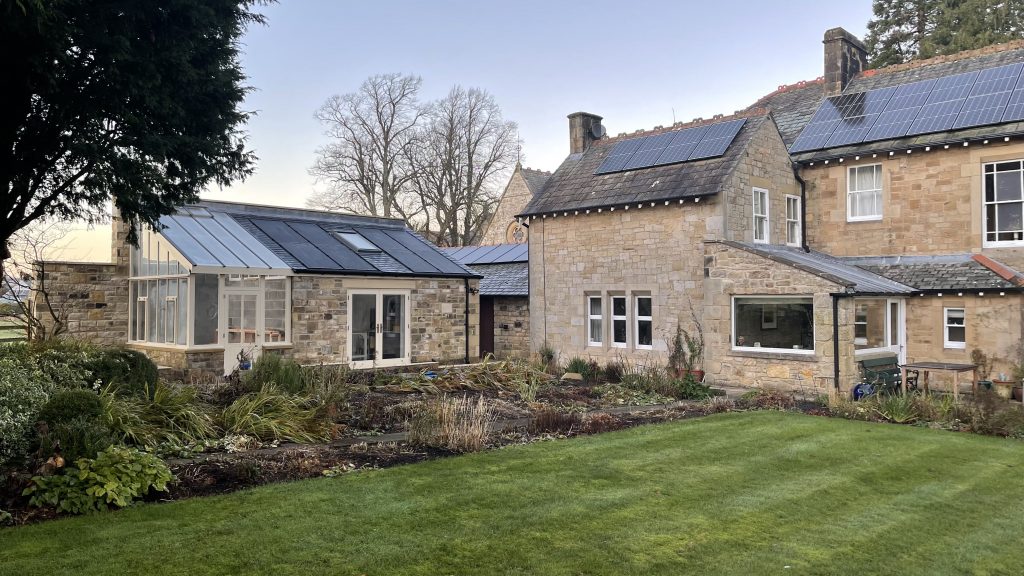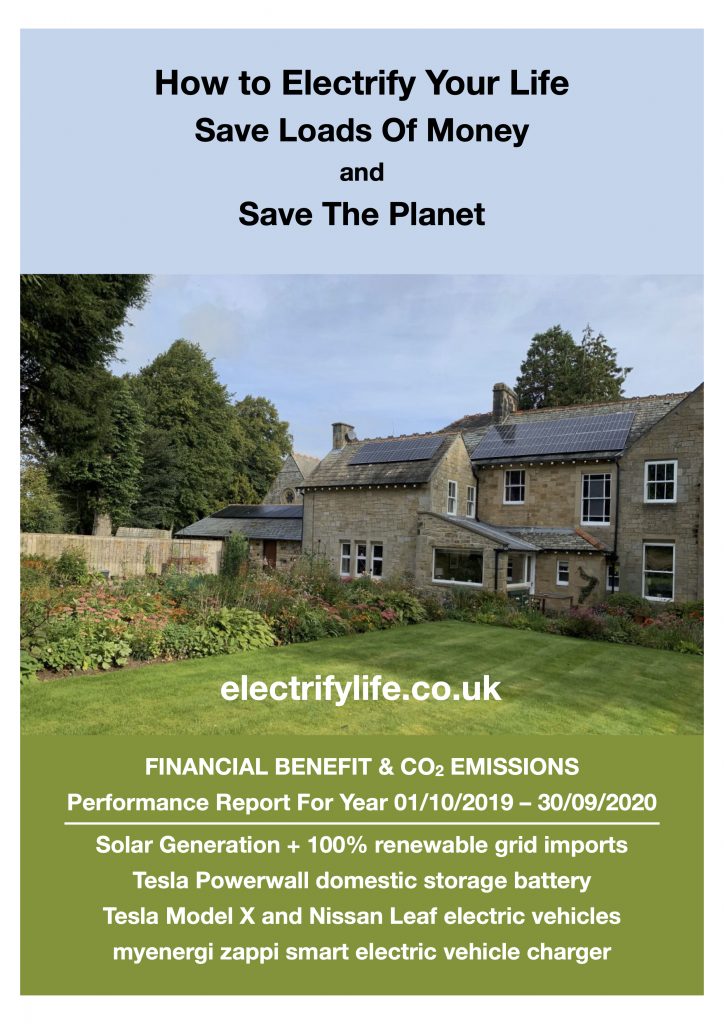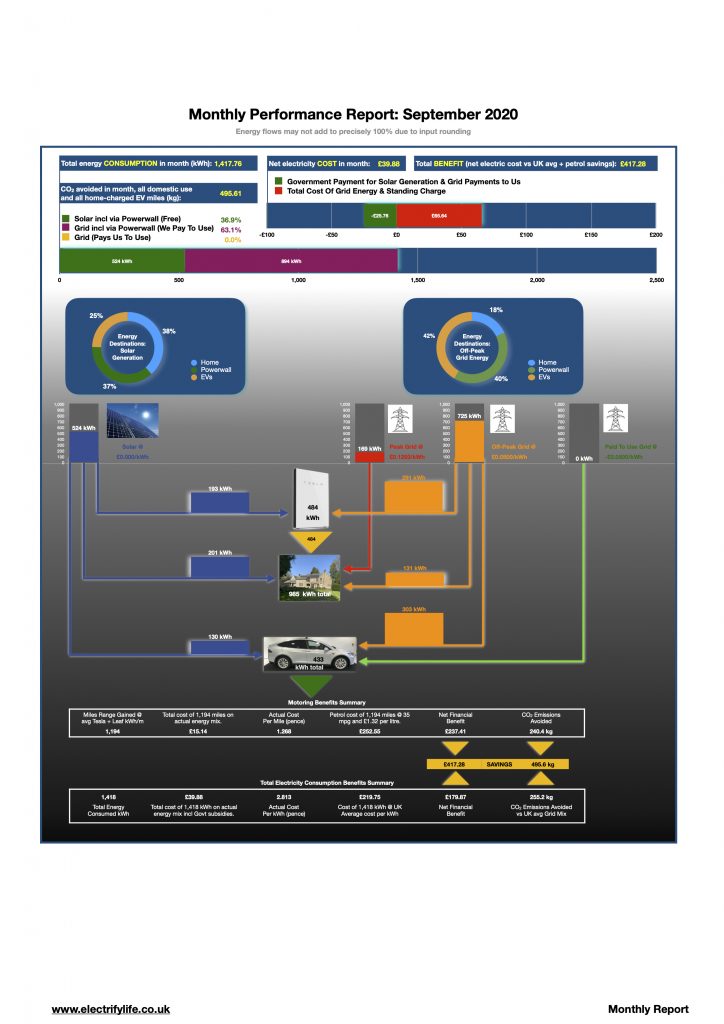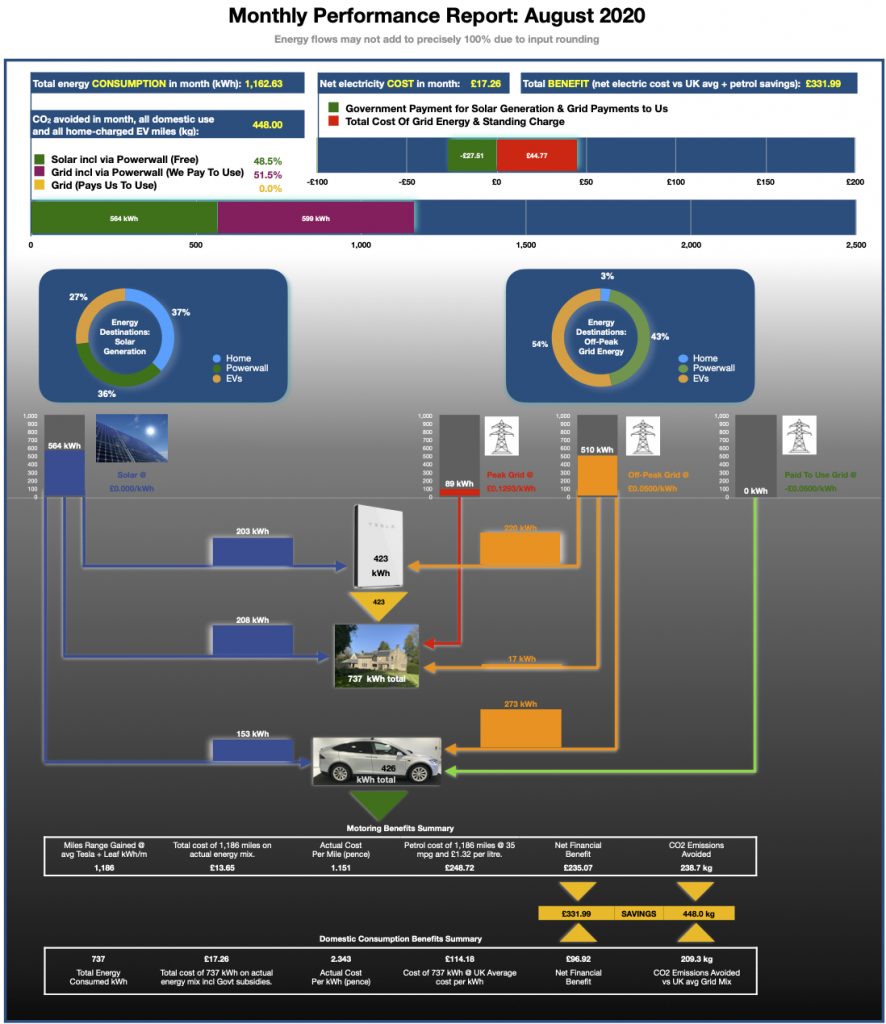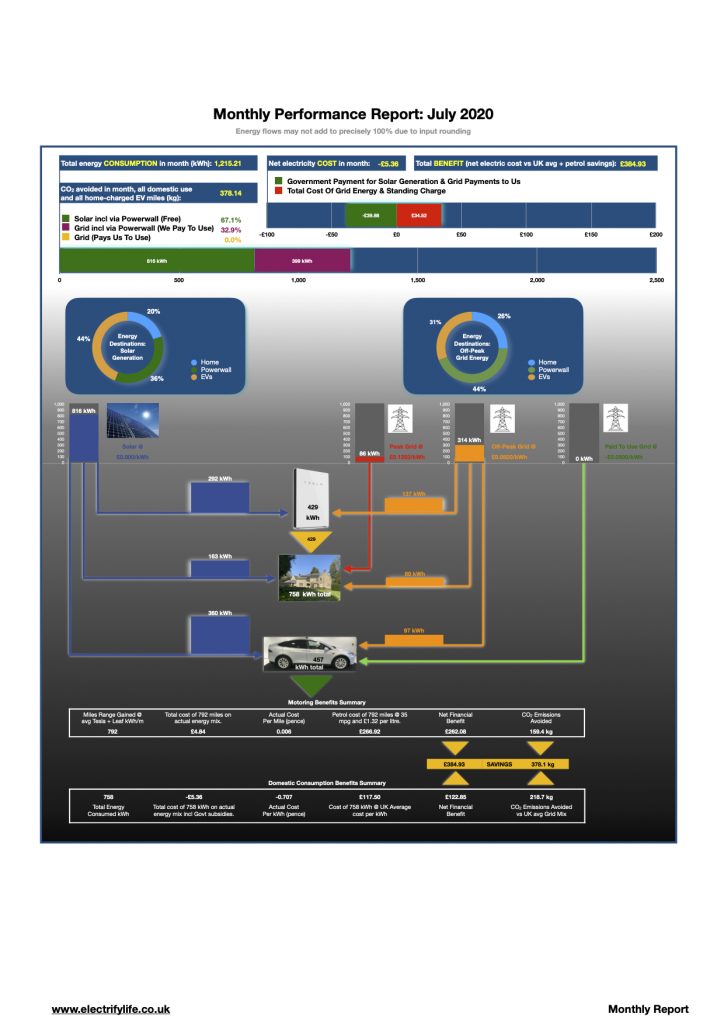We have now assembled the 2023 full year data for energy performance, cash savings, and emissions reduction at our home, resulting from our use of electricity for all our driving, heating, lighting, and all other domestic uses. The results, summarised in this infographic are strongly positive, and have improved cash and carbon savings by around 10% Year on Year, even compared to the very good results achieved in 2022.
In short, we eliminated 27.916 tonnes of CO2 emissions and saved £21,118 in cash
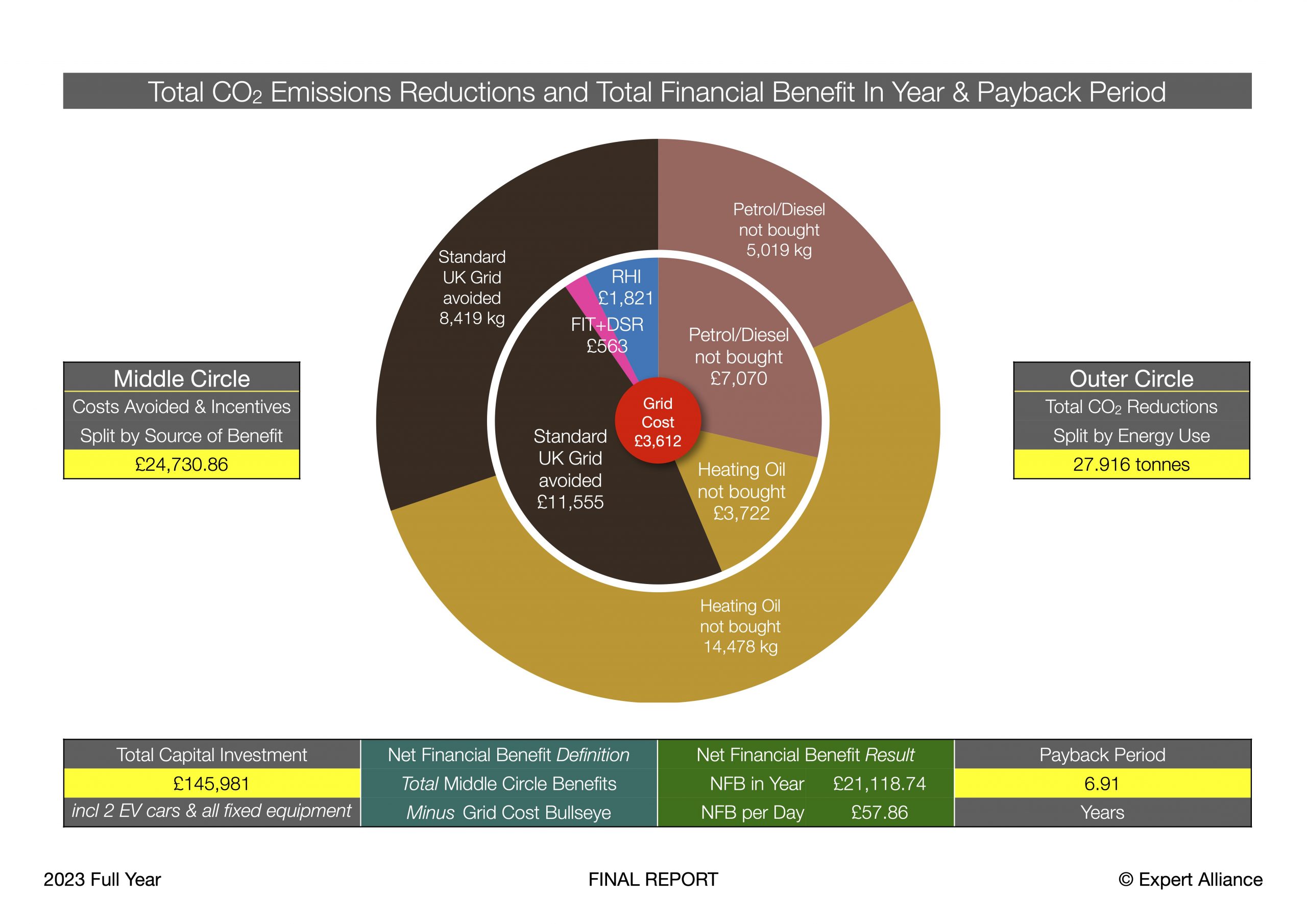
Our savings of 27.916 tonnes of CO2 emissions and £21,118 in cash, are calculated compared to an ‘OldTech’ baseline as follows:
- Driving 25,817 miles (41,548 km) in EVs, rather than petrol cars of equivalent size, saved us over £7,000 in cash and eliminated around 5 tonnes of CO2 emissions.
- Using an Air Source Heat Pump (ASHP), rather than an oil boiler, for central heating and domestic hot water, saved us nearly £4,000 in cash and eliminated around 14.5 tonnes of CO2 emissions.
- Maximising the use of our on-site batteries to import cheap off-peak grid power, and to store the surplus energy from our 7.5MWh of on-site solar generation, saved us well over £11,000 in cash compared to the UK regulated ‘Price Cap’ rate per kWh. Using an officially-certified 100% renewable electricity tariff also eliminated around 8.5 tonnes of CO2 emissions compared to the UK grid average for all suppliers.
- We also received around £2,400 in Government incentive payments, which pay out gradually over time to offset some of the upfront costs we incurred for installing some of the solar array (Feed In Tariff – FIT) and the ASHP (Renewable Heat Initiative – RHI).
- A small part of the incentives received, just over £100, was paid by our energy supplier for our participation in the National Grid Demand Flexibility Service during November and December 2023. DFS pays consumers not to use electricity at times of grid stress, which typically occur when renewable generation is low and demand is high in the evening peaks. Not using electricity in these periods reduces the need to switch on polluting coal and gas fired power stations. Because we have 39 kWh of battery storage available, we are able reduce our grid consumption to absolute zero during the DFS ‘Savings Sessions’.
The ‘hard cash’ economics worked out as set out below.
- Our total energy cost for 2023 was was £3,612 paid to our grid electricity supplier. This one cost covers all the energy we used to power and heat our home, and to power the 25,817 miles (41,548 km) we drove in our cars.
- Offsetting this cost, we saved a total of £22,347 by not buying petrol for the cars, by not buying heating oil for a boiler, and by leveraging our batteries to access a Smart Energy grid supply tariff and therefore not buying energy at the OFGEM ‘price cap’ rate for standard rate electricity.
- Further offsetting the cost, we also received a total of £2,384 in FIT, RHI and DFS incentive payments.
- The 2023 full year Net Financial Benefit to us was £21,119. (£22,347 + £2,384 – £3,612)
- Our total net cost of energy for the full year 2023 was only £1,228, covering all home and motoring consumption. This result is produced by subtracting the £2,384 incentive payments we received from the £3,612 bill we paid to our grid electricity supplier.
- Therefore, our total energy cost was only £3.36 per day, which is less than the typical £4.05 price of a Grande Cappuccino at a well-known coffee chain.
- The net price we paid for electricity after incentives was only 3.28p per kWh, averaged over the year. This takes into account our mix of 19.8% solar, 56.1% off-peak grid, and 24.1% peak grid usage. This compares with the OFGEM ‘price cap’ rate, which varied between 26.58p/kWh and 33.66p/kWh during 2023, in our grid region (Northern England).
- We achieved these savings using the Intelligent Octopus Go Faster tariff for our grid energy. This excellent package works really well for us, providing a minimum of 6 hours cheap overnight electricity at around 25% of the peak-hours cost, but it’s only available to customers who have an electric vehicle. Here’s a link if you’d like to know more. If you sign up to Octopus via the link you will receive £50 off your first bill. For full disclosure, we will receive a £50 referral bonus.
During 2023 the difference in cost between off-peak and peak electricity prices widened significantly as a result of the Ukraine war. This prompted us to invest in one further Tesla Powerwall battery, additional to the two already installed, primarily to increase our capacity to import very cheap overnight off-peak electricity, which now costs around four times less than peak-time power.
The additional battery increased the total capital we have invested to nearly £146,000, but bear in mind that this figure includes two EV cars (a Tesla Model X and a Nissan Leaf), in addition to a 32 panel solar array, and the 3 Tesla Powerwall batteries installed in phases over approximately a decade from 2014 onwards, and a complex ASHP system added in late-2021.
Despite the heavy up-front capex, the system is performing ahead of projections, and is on course to fully pay back the £146,000 investment cost in a total of 6 years 11 months. Taking into account the lower savings we achieved as parts of the system were gradually installed over the seven year period 2014 to 2021, plus the £19,000 we saved in 2022, plus the £21,000 saved this year, we’re accounting the system as 75% paid-off at 31 December 2023. Depending on the amount of sunshine and the price of grid energy, we expect the system to have fully paid for itself by around mid-2025, fully including the cost of both cars. From that point onwards, it’s ‘pure upside’.
Comprehensive data is available in the 2023 Final Report here. It’s a 15 page PDF which presents the information summarised here in full. It can also be accessed by clicking the image at the end of this post.
For comparison, you can view the 2022 Final Report here. In that year, we saved over £19,089 in energy costs, and eliminated 25.5 tonnes of CO2 emissions.
Some thoughts on policy & Net Zero finance
We recognise that we are dealing with a large house here, and that (because we have worked hard and taken risks in our careers) we are in the fortunate position of being able to invest capital up front, in order to save operating costs over time. We fully acknowledge that only a minority of people are in such a position.
In part, we are publishing this data to show what can be achieved if a means is found to enable every household to afford the up-front cost of installing the technologies that will get us collectively to Net Zero.
In this broader context, the data we are publishing provides hard evidence, for policymakers as well as individual citizens, of the financial benefits which flow over time to households making an upfront capital investment in Net Zero technologies.
Although the GreenTech investment in the average home is likely to be smaller (and therefore cheaper), it is self-evident from the results that the substantial financial benefits accruing to any household making such an investment will provide a sustained and predictable stream of income and/or savings. It is precisely this long-term financial predictability which unlocks the possibility of mortgage lenders or social housing finance providers advancing the necessary up-front capital, to be repaid over time from a contractually-guaranteed slice of the savings.
Such an arrangement could perhaps be underwritten by some form of Government ‘backstop of last resort’ if required. Governments frequently provide such ‘backstops’, to underpin the long term finances of centralised projects, such as multi-decade programmes to build nuclear power stations which produce electricity, for example.
Far more rapid results will be achieved by decentralising the investment over the tens of millions of households which consume electricity, most notably by decarbonising domestic heating, by substituting ASHPs for gas boilers, and by installing ‘edge of grid’ energy storage in every home and business premises. Such storage essentially ‘parks’ surplus renewable energy, distributed gradually in off-peak hours, where it’s actually needed. This is a far more rational, and massively cheaper, alternative to agglomerating surplus renewables only in multi-billion pound centralised storage, which then requires multi-billion pound grid upgrades, to allow for ‘distressed distribution’ to tens of millions of points of use, during peak peaks, which will inevitably occur when the wind isn’t blowing in the North Sea and/or the sun isn’t shining on the solar fields around the country.
And here’s the no-brainer. Using a Government guarantee to underwrite a single multi-billion pound project has, by definition, a 1-in-1 exposure to the risk of that project failing and the ‘banker of last resort’ having to pay up, or otherwise bail out the project. Micro-slicing that same type of guarantee into a national programme to equip the UK’s millions of households with Net Zero technology, on the other hand, massively spreads the risk. Reduced to its basics, a 1-in-30,000,000 million risk exposure beats 1-in-1 hands down!
Plans for 2024
No further upgrades or expansions of our GreenTech systems at home are currently planned for 2024. We anticipate simply continuing to operate the system, and continuing eliminate many tonnes of CO2 and save tens of thousands of pounds.
However, we will be completing a very significant new project in the year ahead. We’re taking everything we’ve learned from transforming the energy performance of our home, and are now applying it to the conversion of a redundant 1875 church building into one of the UK’s most energy efficient homes. We believe it to be the first church-to-domestic conversion in the world to Passivhaus standards for ultra-low energy consumption, super-insulation, and airtightness. These standards will massively reduce the Primary Energy Requirement of the building compared to standard home construction.
And the even better news? We’ll be opening Warksburn Old Church as a luxury holiday rental property in late-Summer 2024. We look forward to welcoming you! More information is here, along with the extraordinary history of the Net Zero visionary who funded the original building 149 years ago.
If you are interested in booking a stay, or just want to make an enquiry, please email us on
01 January 2024
